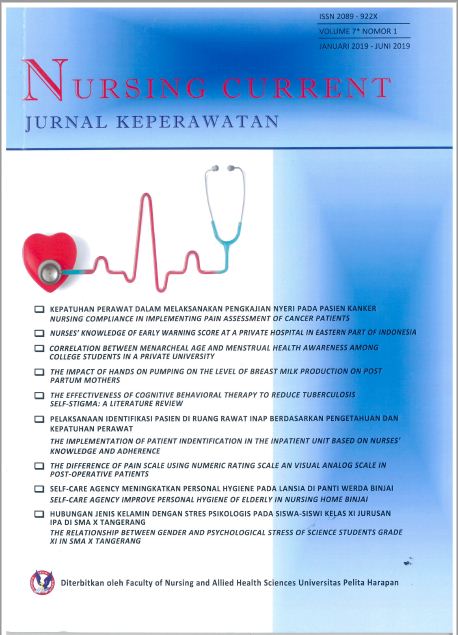THE RELATIONSHIP BETWEEN GENDER AND PSYCHOLOGICAL STRESS IN GRADE 11 SCIENCE STUDENTS AT A HIGH SCHOOL IN TANGERANG [HUBUNGAN JENIS KELAMIN DENGAN STRES PSIKOLOGIS PADA SISWA-SISWI KELAS XI JURUSAN IPA DI SMA X TANGERANG]
DOI:
https://doi.org/10.19166/nc.v7i1.2226Kata Kunci:
psychological stress, genderAbstrak
Stress is a psychological disorder which may cause psychological pressure and heavy feeling. A study of college students in India (2012), showed prevalence of stress in male is higher than female students (57.2% vs 25.2%). This research to identify a correlation between gender and psychological stress in high school students. The method is an unpaired categorical comparative analytic study and conducted with a cross sectional study design. The sample of the study amounted 72 respondents with a purposive sampling method at SMA X Tangerang which consist of grade XI science major students. GHQ-12 (General Health Questionnaire 12) was a questionnaire given to the respondents in order to reveal about psychological stress experienced that will be rated with bimodal scale. The data was collected on February 2019 and analysed using Chi Square. Ethics of this research was approved by the ethical committee, Faculty of Medicine Universitas Pelita Harapan. Results: Result showed a total 72 respondents consist of 37 (51.5%) of male students and 35 (48.6%) of female students. The result also showed 33 respondents (45.8%) experiencing psychological stress disorder consist of 10 (27.03%) of male students and 23 (65.7%) of female students. There is an association between psychological stress with gender in population of high school student grade 11 from science major in SMA X Tangerang with significant p-value 0.002. Conclusions: There is an association between psychological stress with gender in population of high school student grade 11 from science major in SMA X Tangerang.
BAHASA INDONESIA Stres adalah kondisi medis psikologis yang dialami dalam kehidupan manusia, yakni merupakan perasaan mengalami ketegangan dan tekanan. Penelitian pada tahun 2012 di Universitas di India menunjukkan prevalensi stres pada mahasiswa laki-laki (57,2%) lebih tinggi daripada mahasiswi perempuan (25,2%). Tujuan penelitian untuk mengidentifikasi hubungan antara jenis kelamin dan stres psikologis pada siswa-siswi SMA jurusan IPA. Penelitian ini adalah analitik komparatif kategorik tidak berpasangan yang dilaksanakan dengan desain penelitian potong lintang. Sampel penelitian ini berjumlah 72 responden dengan menggunakan metode purposive sampling yang terdiri dari siswa-siswi kelas XI jurusan IPA di SMAK X Tangerang. GHQ-12 (General Health Questionnaire-12) diberikan untuk mengukur bila responden mengalami stres psikologis yang akan dinilai menggunakan skala bimodal. Pengambilan data dilaksanakan pada bulan Februari 2019 dan dianalisa dengan Chi Square. Etika persetujuan penelitian ini disetujui oleh Komite Etik Fakultas Kedokteran Universitas Pelita Harapan. Hasil penelitian menunjukkan dari 72 responden, 37 (51,4%) di antaranya berjenis kelamin laki-laki dan 35 (48,6%) lainnya berjenis kelamin perempuan. Dari data penelitian ini juga ditemukan bahwa terdapat 33 (45,8%) yang mengalami gangguan stres psikologis dimana 10 (27,03%) berjenis kelamin laki-laki dan 23 (65,7%) berjenis kelamin perempuan. Hasil penelitian menunjukkan bahwa jenis kelamin berhubungan dengan stres psikologis pada siswa-siswi kelas XI jurusan IPA di SMA X Tangerang (p-value 0,002). Terdapat hubungan antara jenis kelamin dengan stres psikologis pada siswa-siswi kelas XI jurusan IPA di SMA X Tangerang.
Referensi
Balhara, Y. S., Verma, R., & Gupta, C. (2012). Gender differences in stress response: Role of developmental and biological determinants. Industrial Psychiatry Journal, 20(1), 4. https://doi.org/10.4103/0972-6748.98407
Droogenbroeck, F. V., Spruyt, B., & Keppens, G. (2018). Gender differences in mental health problems among adolescents and the role of social support: Results from the Belgian health interview surveys 2008 and 2013. BMC Psychiatry, 18(1). https://doi.org/10.1186/s12888-018-1591-4
Greenberg, J. S. (2006). Comprehensive stress management (10th ed.). New York, NY: McGraw-Hill.
Jayanthi, P., Thirunavukarasu, M., & Rajkumar, R. (2015). Academic stress and depression among adolescents: A cross-sectional study. Indian Pediatrics, 52(3), 217-219. https://doi.org/10.1007/s13312-015-0609-y
Junadi, P., Soemasto, A. S., & Amelz, H. (2001). Kapita selekta kedokteran (3th ed.). Jakarta, Indonesia: Penerbit Media Aesculapius, Fakultas Kedokteran, Universitas Indonesia.
Kaistha, M., Raina, S. K., Bhardwaj, A., K., Chander, V. , Kumar, D., & Sharma, S. (2013). A screening for presence of psychological distress among medical students of a medical college in rural north west India. International Journal of Clinical Psychiatry, 1(1), 20-23.
Kordi, M., & Mohamadirizi, S. (2015). The relationship between food frequency and menstrual distress in high school females. Iranian Journal of Nursing and Midwifery Research, 20(6), 689. https://doi.org/10.4103/1735-9066.170000
Kupriyanov, R., & Zhdanov, R. (2014). The eustress concept: Problems and out-looks. World Journal of Medical Sciences, 11(2), 179-185.
Lazarus, R. S. (1993). From Psychological Stress to the Emotions: A History of Changing Outlooks. Annual Review of Psychology, 44(1), 1-22. https://doi.org/10.1146/annurev.ps.44.020193.000245
Musradinur. (2016). Stres Dan Cara Mengatasinya Dalam Perspektif Psikologi. Jurnal Edukasi: Jurnal Bimbingan Konseling, 2(2), 183-200. https://doi.org/10.22373/je.v2i2.815
Putri, W. D. A. W. (2014). Prevalensi stres psikososial dan faktor-faktor yang mempengaruhi pada siswa-siswi kelas XII studi Pendidikan IPA dan IPS SMAN 6 Denpasar. E-Jurnal Medika Udayana, 3(11). https://ojs.unud.ac.id/index.php/eum/article/view/11945
Schwabe, L., & Wolf, O. T. (2012). Stress Modulates the Engagement of Multiple Memory Systems in Classification Learning. Journal of Neuroscience, 32(32), 11042-11049. https://doi.org/10.1523/JNEUROSCI.1484-12.2012
Yonkers, K. A., O'brien, P. S., & Eriksson, E. (2008). Premenstrual syndrome. The Lancet, 371(9619), 1200-1210. https://doi.org/10.1016/S0140-6736(08)60527-9
Unduhan
Diterbitkan
Cara Mengutip
Terbitan
Bagian
Lisensi
Authors who publish with this journal agree to the following terms:
1) Authors retain copyright and grant the journal right of first publication with the work simultaneously licensed under a Creative Commons Attribution License (CC-BY-SA 4.0) that allows others to share the work with an acknowledgement of the work's authorship and initial publication in this journal.
2) Authors are able to enter into separate, additional contractual arrangements for the non-exclusive distribution of the journal's published version of the work (e.g., post it to an institutional repository or publish it in a book), with an acknowledgement of its initial publication in this journal.
3) Authors are permitted and encouraged to post their work online (e.g., in institutional repositories or on their website). The final published PDF should be used and bibliographic details that credit the publication in this journal should be included.

This work is licensed under a Creative Commons Attribution-ShareAlike 4.0 International License.






